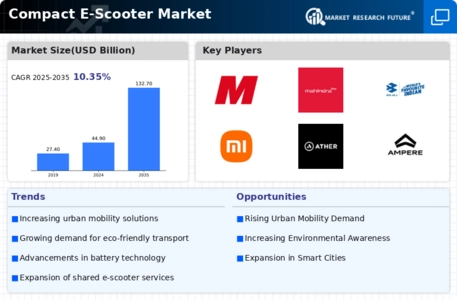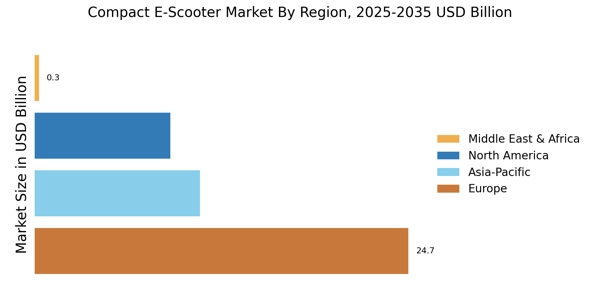Rising Urbanization
The Compact E-Scooter Market is experiencing a surge in demand due to increasing urbanization. As more individuals migrate to urban areas, the need for efficient and convenient transportation options becomes paramount. Urban centers are often congested, making traditional vehicles less practical. E-scooters offer a nimble alternative, allowing users to navigate through traffic with ease. According to recent data, urban populations are projected to reach 68% by 2050, further driving the need for compact mobility solutions. This trend suggests that the Compact E-Scooter Market will continue to expand as cities adapt to accommodate these vehicles, integrating them into public transport systems and urban planning initiatives.
Environmental Concerns
The Compact E-Scooter Market is significantly influenced by growing environmental concerns. As awareness of climate change and pollution rises, consumers are increasingly seeking eco-friendly transportation alternatives. E-scooters produce zero emissions during operation, making them an attractive option for environmentally conscious individuals. Recent studies indicate that the transportation sector accounts for approximately 14% of global greenhouse gas emissions, highlighting the potential impact of adopting e-scooters. This shift towards sustainable transportation solutions is likely to bolster the Compact E-Scooter Market, as both consumers and governments prioritize reducing carbon footprints and promoting cleaner urban environments.
Government Initiatives
Government initiatives aimed at promoting sustainable transportation are significantly impacting the Compact E-Scooter Market. Many governments are implementing policies that encourage the use of electric vehicles, including e-scooters, through subsidies, tax incentives, and infrastructure development. For instance, cities are increasingly investing in dedicated e-scooter lanes and charging stations, facilitating easier access for users. Recent reports indicate that government funding for electric mobility projects has increased substantially, suggesting a commitment to fostering the growth of the Compact E-Scooter Market. These initiatives not only enhance the appeal of e-scooters but also contribute to the overall development of sustainable urban transport systems.
Technological Advancements
Technological advancements play a crucial role in shaping the Compact E-Scooter Market. Innovations in battery technology, such as lithium-ion batteries, have enhanced the performance and range of e-scooters, making them more appealing to consumers. Additionally, the integration of smart technology, including GPS tracking and mobile app connectivity, has improved user experience and safety. Data suggests that The Compact E-Scooter is expected to grow at a compound annual growth rate of over 7% through the next few years, indicating a robust demand for technologically advanced e-scooters. This trend underscores the importance of continuous innovation within the Compact E-Scooter Market.
Changing Consumer Preferences
Changing consumer preferences are reshaping the Compact E-Scooter Market. As urban dwellers seek more flexible and convenient transportation options, e-scooters are becoming a preferred choice for short-distance travel. The rise of the sharing economy has also contributed to this trend, with many consumers opting for e-scooter rental services instead of ownership. Recent surveys indicate that a significant percentage of consumers are willing to use e-scooters for their daily commutes, reflecting a shift in attitudes towards personal mobility. This evolving consumer behavior is likely to drive growth in the Compact E-Scooter Market, as manufacturers and service providers adapt to meet the changing demands of the market.


















Leave a Comment